Carry convincing and inspiring bass tones with you wherever you go, see our list of highly recommended portable bass amps.
While beginners and students get the most benefit from portable amps, professionals will also find them to be practical alternatives to bulky amps in many situations, such as songwriting, practicing and small venue gigs. So whatever your skill level is, you’ll want to consider having one of these compact amps ready for when inspiration strikes at odd places, or for quick jammings.
Like last time, we considered important factors like weight, size and portability features that include durability, reliability and the ability to be battery powered. Also prioritized are amps that sound good for both individual practice and for low volume jamming.
If you’re looking for full sized amps then check out our roundup of the Best Bass Amps instead.
Roland Micro Cube Bass RX
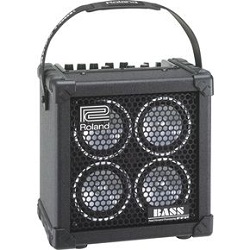
Roland’s portable amp Cube series is very popular because they are affordable, flexible and reliable, and they are packed in lightweight and convenient cube combo amp configuration. This practical and effective design is also applied to the Roland Micro Cube Bass RX, helping it secure the top spot in this best portable bass amp roundup.
This bass amp is very easy to carry around, weighing in at just 15 lbs. But despite its small size, it produces bass tones that truly satisfy, thanks to its unique 4-speaker configuration that gives it a “bigger” and thicker tone even at low volumes. It is like having a 4-speaker bass combo configuration that won’t break your back, won’t mess with your relationships, and more importantly, won’t break your bank.
Aside from good tone, it also comes with eight built-in Boss technology COSM amps, six digital effects, 3-band EQ, and a chromatic tuner. The amp also carries Roland’s brand of stereo chorus and reverb effects that sound impressive for an amp this small. To ensure its edge over the other amps, Roland designed the Micro Cube Bass RX to run on AA battery power which is extremely convenient. Finally, you can get all these nifty features at a price point that is truly practical. Get the latest price & reviews at Amazon.com
Phil Jones Bass Briefcase
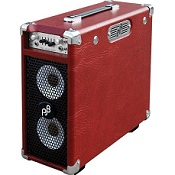
Although not as well known as the other amps on this list, the Phil Jones Bass Briefcase is what experienced bass players will consider as the best sounding among the bunch. It may not have digital versatility, but it provides great sounding bass tones with minimal setup and tweaking, courtesy of its low noise preamp.
Basic tone shaping is done through the amp’s 5-band EQ and it comes with a nifty optical limiter. Weighing in at just 30 lbs, this portable bass amp has enough muscle to operate at up to 100 watts RMS, firing its low registers through 5″ twin speakers in a speaker enclosure that looks like a briefcase. An option battery is also available, making the PJPS Briefcase Bass amp ideal for bassists that want classic bass tones in a portable package. If not for its premium price tag, the Phil Jones Bass Briefcase could probably be sitting at the top of this list, still experienced players who can afford this portable bass amp will find it to be a worthy investment. Manufacturer: Phil Jones Pure Sound | Get the latest price & reviews at Amzon.com
Hartke HD25
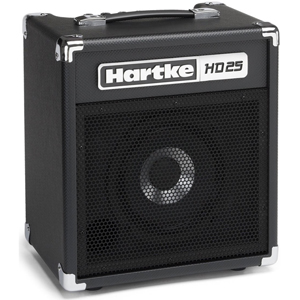
Hartke is widely known for their professional touring bass amps, as seen on the rigs of big name bassists like Billy Sheehan, Victor Wooten, Stu Hamm and many more. Thankfully they are also known for providing great sounding bass tones at affordable prices, so we were able to add a portable Hartke amp on this list.
The Hartke HD25, is among the smallest and lightest in their range. It is a 25 Watt 1×8″ bass combo amp that comes in a small-foot print cabinet that is easy to carry around. It brings with it the same full sounding and clean low end expected of more expensive Hartke amps, but at a smaller package and for small venue use. The amp is equipped with an 8-inch HyDrive Speaker which features a half paper, half aluminum cone, designed to reproduce fuller tones at lower volumes.
Frequency shaping is provided by its 3-band EQ and the amp is practice friendly with its headphones out and aux input. Weighing in at 29lbs, this portable amp is light on both your hands and on your pocket. Get the latest price & reviews at Amazon.com
Pignose Hog 30 Amp
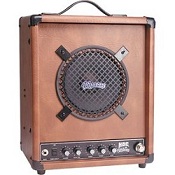
The Pignose Hog 30 is just a straight forward amplifier that comes with master volume and 3-band EQ controls. Nothing fancy, just basic bass tones in bedroom friendly levels which can go up to 30 Watts for small venue gigs. However, the amp’s simple controls and classic exterior makes it stand out from among the many “feature-packed” portable amps in the market, and will surely appeal to fans of vintage amplifiers.
Although it doesn’t have many tone options, its open sound makes the amp more flexible, able to handle bass effects pedals, acoustic guitars and even keyboards without any problems. If you need more bass character, the amp comes with a Funk Bass switch that adds extra punch and depth. Another notable feature is its battery that conveniently charges when plugged in – it gives you hours of “unplugged” amplification anywhere you bring this 28 lbs amp to. Finally, the Pignose Hog 30 is quite affordable, an ideal portable bass and utility amp that will not empty your wallet. Get the latest price & reviews at Amazon.com
Ampeg BA-108 V2
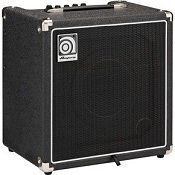
Ampeg is another well known bass amplification brand with a long list of bassists that use their gear like Les Claypool, Gene Simmons and Stanley Clarke just to name a few – so it was surprising to find the Ampeg BA-108, a great portable amp at a very affordable price range! Although Ampeg says that the BA-108 is ideal for beginners with its CD/MP3 input and headphone out, this amp can also be a great portable amplifier for experienced players.
The Ampeg BA-108 lets you conveniently take the classic Ampeg sound anywhere, in a small and easy to carry 27 lbs 1×8″ combo format. To get the signature sound at lower volumes, the amp has a ported baffle which helps enhance the lower frequencies. Since the amp is aimed at newbies, it comes with minimalist 3-band EQ, for making minor adjustments. If you are working within a limited budget, this is highly recommended. Get the latest price & reviews at Amazon.com
Vox PB10 Pathfinder Bass Amp
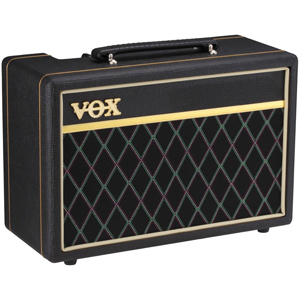
Since portability is the primary deciding factor for this list, we have found that the Vox PB10 Pathfinder Bass Amp to be deserving of a spot. Weighing in at just over 14 lbs, this super light “Mini” amp is highly portable, convenient to use and remarkably practical, you can carry it around without much hassle.
Students of the instrument will find the amp’s straightforward operation and clean tone to be very conducive for building up chops. Even professional musicians will enjoy the Vox PB10 Pathfinder Bass Amp for warming up in the dressing room. Although it doesn’t have the louder volume of bigger practice amp, the sound quality is not compromised. Finally, the most affordable amp in this list carries with it the visual appeal of bigger Vox amps, and it truly is a nifty tool for bassists of all playing levels. Get the latest price & reviews at Amazon.com
Markbass Micromark
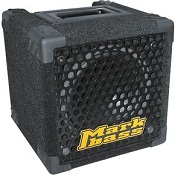
Markbass, known for their bass effects and powerful amps have their own portable and practice amps available in the market – our favorite of the bunch is the Markbass Micromark. Despite its straightforward look and specifications, many bassists attest to its impressive heavy tone which contrasts its 9.26 lbs weight. This small amp measures less than 9″ in any direction, yet it pumps out 50W of power onto a small 6″ speaker, providing the quality of sound expected from the brand.
Beginners will love the CD or MP3 mini-plug for practicing. Experienced bassists on the other hand will enjoy the Micromark’s tone versatility, thanks to its variable Pre-shape filter, which can boost lows around 35Hz and highs around 10kHz, and cutting mids at 380Hz. Unfortunately you will have to save up more for this quality piece of equipment. We join experienced bassists in stating that this amp is worth every penny and recommend it to those that can afford it. Manufacturer: MarkBass | Get the latest price at Amazon.com
Related News:
Did you know you can get a Battery Powered Amplifier?

I’m a guitarist that has picked up bass (and is learning it’s unique qualities). I own and frequently use a Hartke A-35 bass portable amp (which is a heavy 35 plus pounds). I have played through a Pignose Hog 30 and bought and sold off my Roland Micro Cube Bass Rx. I also have a Vox Bass Amplug for headphone use only. Here are my somewhat biased opinions: 1) Portable Bass Amps are an oxymoron. Anything that projects bass tone and volume is about 30 watts. If you intend to play with a band and can only afford one amp, don’t go for less or no one will hear you. 2) The Roland Micro Cube is lovely. It has drum tracks and tuner and effects and bass cabinet mods. It does not project well. Nice for a tiny room or dorm. Pricey though for the size. 3) The Pignose Hog 30 is awesome. Clean tones and plenty loud enough for busking (my friends use it for harmonica and guitar as well). It has a headphone jack, lines out and contour controls. It’s 25 + lbs, but doable to schlep around. The hinky part is the battery because it needs mindfulness. You have to let it run down before recharging or the battery will not recharge 100%. You also can’t let it overcharge. Love it or hate it, but it’s got charm. 4) Hartke no longer makes my amp, but I’d recommend the brand for anyone seeking quality of build and tone. Their solid state amps have a remarkably clean tone and usually will have line out, headphone jacks, tone contours and what should sell ya is the aluminum speaker cone that won’t blow out if you play too loud or hard. Solid compact wood cab on mine with a metal grate over the cone, it’s a tough beastie. 35 watts gets pretty loud and yet loses no tonal qualities at lesser volumes. I have a pedal board plugged in mine and use it for my guitars as well. One of the best amp buys I ever made, albeit not lightly portable because it weighs about as much as my Vox AC15. 5) The Amplug Bass Headphone jack amp: No matter what jack amp you buy, you’ll experience some sort of hiss through the headphones as well as a volume limiter. I hate that. Vox Bass has less hiss than most though. It offers 3 gain stages that seem to effect the output of volume as well. It also comes with rhythm tracks for jamming. At about 40 bucks of family and neighbors won’t chase you with torches and pitchforks, it ain’t bad. It doesn’t project, obviously. And frankly…all the above have headphone jacks as well. Finally: Most of us don’t have a lot of money especially if we’re new and not sure we’re going to stay with a musical commitment. I’ve changed out a lot of gear because I was dumb and didn’t know how to modify tone on an amp or guitar or bought something too tricked out to give me something to lock onto or even just what I wanted to pursue as genre or tonal ability. My best advice is to buy a great clean amp with enough room/volume/capability to grow. Add pedals to taste…it’s cheaper than changing gear. And in bass, portability is relative to the heaviness of tone and volume. Have fun! : )
I have a BG250 one of the first ones comes with one tone print and one tube amp modulator.
As light as it was for its time its a little bulky for practice sessions in my buddies living room.
Looking for something small, Light and that does not sound too bad and reasonably priced.